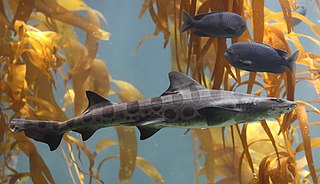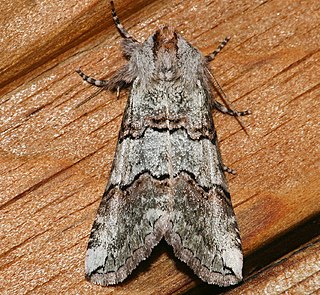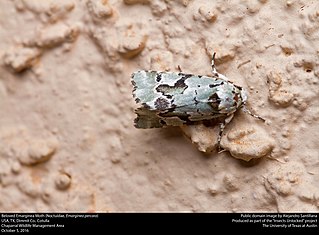
The leopard shark is a species of houndshark, in the family Triakidae. It is found along the Pacific coast of North America, from the U.S. state of Oregon to Mazatlán in Mexico. Typically measuring 1.2–1.5 m (3.9–4.9 ft) long, this slender-bodied shark is immediately identifiable by the striking pattern of black saddle-like markings and large spots over its back, from which it derives its common name. Large schools of leopard sharks are a common sight in bays and estuaries, swimming over sandy or muddy flats or rock-strewn areas near kelp beds and reefs. They are most common near the coast, in water less than 4 m (13 ft) deep.
In zoological nomenclature, a nomen oblitum is a disused scientific name which has been declared to be obsolete in favour of another "protected" name.

The masked tityra is a medium-sized passerine bird. It has traditionally been placed in the cotinga or the tyrant flycatcher family, but evidence strongly suggests that it is better placed in Tityridae, where it is now placed by the South American Classification Committee.

Chamaita is a genus of moths in the subfamily Arctiinae. The genus was erected by Francis Walker in 1862. Species are distributed throughout India, Sri Lanka, and Borneo.

Grotella is a genus of moths of the family Noctuidae first described by Leon F. Harvey in 1875.
Taphonia is a genus of moths of the family Erebidae. The genus was described by William Schaus in 1916.

Macroglossum semifasciata, the half-banded hummingbird hawkmoth, is a moth of the family Sphingidae. It is known from north-eastern India, Myanmar, Thailand, south-western China, Vietnam, Malaysia and Indonesia.
Ceranemota albertae, the Alberta lutestring, is a species of moth of the family Drepanidae first described by John Frederick Gates Clarke in 1938. It is found in western Canada, from south-central British Columbia east to south-eastern Saskatchewan. The habitat consists of dry open woodlands and shrub areas with wild cherry.

Orthenches semifasciata is a moth of the family Plutellidae. It is endemic to New Zealand.
Aglossa gigantalis is a species of snout moth in the genus Aglossa. It was described by William Barnes and Foster Hendrickson Benjamin in 1925 and is found in North America, including the type location of Arizona.
Gazoryctra novigannus is a moth of the family Hepialidae first described by William Barnes and Foster Hendrickson Benjamin in 1926. It is known in North America, from Quebec, west to the Rocky Mountains and south to Arizona.
Chamaita semifasciata is a moth of the family Erebidae. It is found on the Dampier Archipelago.

Ceranemota is a genus of moths belonging to the subfamily Thyatirinae of the Drepanidae.

Ceranemota improvisa is a moth in the family Drepanidae. It was described by Henry Edwards in 1873. It is found in North America, where it has been recorded from northern California, western Oregon, western Washington and south-western British Columbia. Adults are on wing from late September to November in one generation per year.

Ceranemota fasciata is a moth in the family Drepanidae. It was described by William Barnes and James Halliday McDunnough in 1910. It is found in North America, where it has been recorded from British Columbia to northern California. It is also present in coastal southern Alaska. The habitat consists of coastal rainforests, mixed hardwood forests and montane riparian areas.

Ceranemota crumbi is a moth in the family Drepanidae. It was described by Foster Hendrickson Benjamin in 1938. It is found in North America, where it has been recorded from western Oregon and the Washington Cascade Range. Its habitat consists of coastal rainforests and mixed hardwood forests.

Ceranemota tearlei is a moth in the family Drepanidae. It was described by Henry Edwards in 1888. It is found in North America, where it has been recorded from British Columbia and central Alberta south to central California in the west and to Utah and Colorado in the Rocky Mountains. The hindwings are lighter grey with somewhat darker markings. Adults are on wing from late August to October in one generation per year.
Ceranemota partida is a moth in the family Drepanidae. It was described by John Frederick Gates Clarke in 1938. It is found in North America, where it has been recorded from northern Colorado.

Psaphidini is a tribe of owlet moths in the family Noctuidae. There are at least 40 genera and at least 90 described species in Psaphidini.









